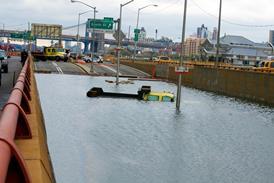Data generated by construction projects tends to be on a small, local scale but if we are to plan for smart cities we need to embrace big data

Summer is a distant memory, but the old tradition of building sandcastles is still going strong in my family. This summer we certainly built a few on holiday in Norfolk. With the castles built and moats dug, we had to collect water to fill the moat, but of course the buckets were too small and the water drained away faster than it could be replenished. So a new plan was hatched, to open up a channel to the sea and wait for the tide to turn. Initially this was a good plan, with water flowing into the moat but soon the structures were engulfed by the sea and the castle collapsed. It turns out the plan was not smart enough.
Big data is a new phrase for our industry, it describes a situation which arises when the volume of data we hold becomes so vast it is difficult to store, process, and visualise. As BIM is increasingly adopted for our projects we are generating buckets upon buckets of data.
Construction is likely to reach the threshold where data starts to feel ‘big’ rather early because of our fragmented and project-orientated structure and lack of past exposure to really big data
How much data must you have before it qualifies as big data? The answer it turns out is not just about the amount of data, but also our capacity to manage it. The construction industry is structured in such a way that we tend to have little experience of lots of data. Nonsense I hear you challenge, just look at the thousands of documents and drawings which make up a typical project! But my point is that we sub-divide our data by projects and work packages and the data itself is generated by project teams formed to achieve narrowly defined deliverables, often with little connection to the bigger picture and the long-term.
Construction is likely to reach the threshold where data starts to feel ‘big’ rather early because of our fragmented and project-orientated structure and lack of past exposure to really big data. We are used to working with relatively small buckets. Delivering a successful project is about managing the detail – yes, with the end goal always in mind, but rarely thinking beyond the outcomes and associated stakeholder requirements defined by the boundary of the project. Interoperability between software platforms and data formats will help bring together big data views to form an estate-wide or regional view, but will not be sufficient to adequately support smart cities, smart regions or one day perhaps even a smart planet. We need to learn to think differently, we need to learn to think big.
Smart cities need big data, in turn this will allow us to create and maintain a built environment which is connected to the people who use it. Big data will allow us to optimise our use of space on an increasingly crowded planet, and our use of energy and natural resources in a world where these resources are increasingly under pressure. The answer to big data is not bigger buckets, we need a new plan – and it has to be a smart one if we are not to become overwhelmed by the incoming tide of data.
Adrian Malone is a director at Faithful+Gould with responsibility for BIM, knowledge management and commercial research



























1 Readers' comment